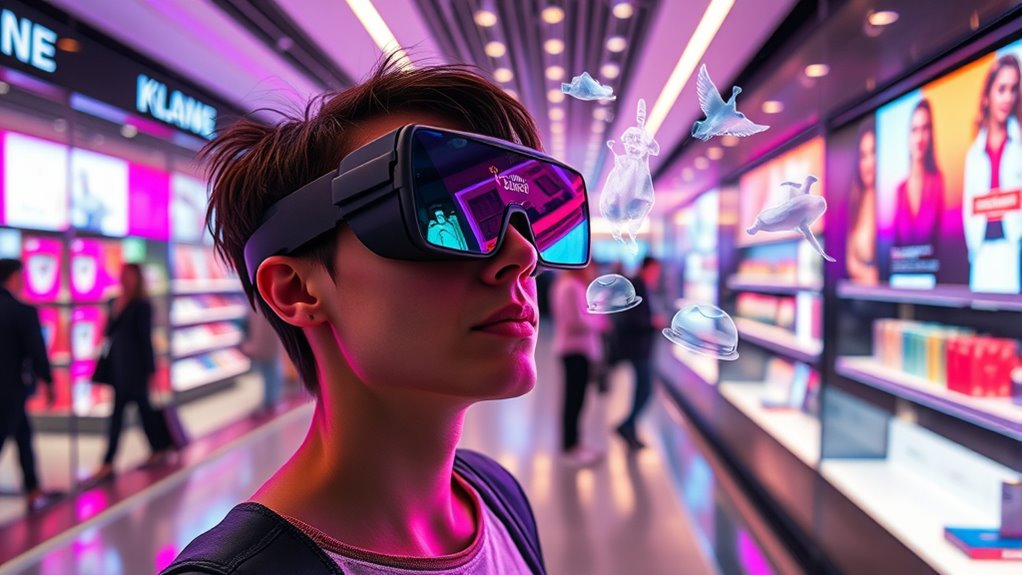The rise of augmented reality marketing campaigns transforms how you engage with brands by blending digital and physical worlds for immersive experiences. You can virtually try on products, explore interactive billboards, or walk through virtual showrooms. These campaigns boost your engagement, making shopping more fun and personalized. They turn passive viewers into active participants, creating stronger brand connections. Keep exploring to discover how these innovative strategies could reshape your entire shopping journey.
Key Takeaways
- AR marketing creates immersive, interactive experiences that enhance consumer engagement and brand loyalty.
- Virtual try-ons allow personalized, real-time product visualization, reducing purchase hesitation.
- Interactive billboards and AR activations capture attention and boost brand memorability.
- AR campaigns enable virtual walkthroughs and storytelling, fostering deeper emotional connections with consumers.
- Continuous innovation blurs digital and physical worlds, transforming passive viewers into active participants.

Have you ever wondered how brands are transforming the way you experience products and services? It’s all thanks to the rise of augmented reality (AR) marketing campaigns, which blend digital and physical worlds to create engaging, interactive experiences. Instead of just seeing a product on a shelf or in a catalog, you can now immerse yourself in virtual environments that bring products to life right before your eyes. This technology isn’t just a novelty; it’s reshaping consumer interactions and influencing purchasing decisions in profound ways.
One of the most popular AR innovations is virtual try-ons. Imagine walking into a store or browsing online and effortlessly trying on clothes, glasses, or makeup without ever physically touching them. Virtual try-ons leverage AR to overlay digital images onto your real-world view through your smartphone or AR glasses. This makes the shopping process faster, more personalized, and less frustrating. You can see how a pair of sunglasses looks on your face or how a lipstick shade complements your skin tone—all in real-time. These experiences reduce the hesitation that often accompanies online shopping because they give you a clearer sense of how a product fits or looks before you commit to buying.
Meanwhile, brands are also deploying interactive billboards that captivate passersby. These billboards go beyond static advertisements; they engage you directly through AR. When you approach or scan a QR code, the billboard springs to life, offering a virtual experience related to the product or campaign. You might see a 3D model of a new car, or watch a digital character interact with the environment around you. These interactive billboards not only grab your attention but also encourage you to participate actively, making the advertising memorable and more likely to influence your purchasing choices.
AR campaigns also foster deeper brand engagement by creating immersive environments that tell stories or showcase products in dynamic ways. For example, some brands let you walk through a virtual showroom, trying out different product features or visualizing how items will look in your space. This seamless integration of AR and marketing makes the process feel more natural and enjoyable, leading to increased brand loyalty and customer satisfaction. Additionally, the use of vetted AR marketing strategies ensures that campaigns are both effective and respectful of user privacy, building trust and reliability.
Ultimately, augmented reality marketing campaigns are about making your experience more interactive, personalized, and fun. They break down traditional barriers between consumers and products, turning passive viewers into active participants. Whether it’s virtual try-ons or interactive billboards, AR is helping brands capture your attention in more compelling ways, ensuring that shopping becomes less of a chore and more of an exciting adventure. As AR technology continues to evolve, expect even more innovative ways for brands to connect with you—blurring the lines between digital and real-world experiences.
Frequently Asked Questions
How Do AR Campaigns Measure ROI Effectively?
You can measure ROI for AR campaigns effectively by implementing measurement strategies that track user engagement, conversions, and sales. Use data analytics tools to analyze real-time data, such as app interactions, time spent, and purchase behavior. These insights help you understand campaign impact and optimize future efforts. Regularly reviewing these metrics guarantees you accurately gauge ROI, making your AR marketing investments more targeted and successful.
What ARe the Best Platforms for AR Marketing?
You should focus on platforms like Snapchat, Instagram, and TikTok for AR marketing, as they excel in AR content creation and offer seamless platform integration. These platforms provide easy-to-use tools for developing engaging AR experiences, helping you reach your target audience effectively. By leveraging their built-in features and large user bases, you can maximize your campaign’s impact and measure ROI more precisely through their analytics tools.
How Can Small Businesses Implement AR on a Budget?
You can implement AR on a budget by focusing on simple AR content creation using budget-friendly tools like Spark AR or Lens Studio. These platforms allow you to develop engaging AR experiences without extensive technical skills or costs. Start small with interactive filters or product visualizations, and gradually expand as you see results. Leveraging free templates and community resources can also help you save money while creating compelling AR campaigns.
What Privacy Concerns ARise With AR Marketing?
Privacy pitfalls plague augmented reality marketing, prompting you to ponder data privacy and user consent. As you develop AR campaigns, remember that collecting personal info without permission can damage trust and breach laws. Always prioritize transparency, seek clear user consent, and safeguard data diligently. By doing so, you protect both your audience and your brand’s reputation, ensuring your innovative efforts stay ethical and effective without entangling in privacy problems.
How Do Consumers Typically Respond to AR Experiences?
You usually find AR experiences engaging and exciting, especially when they feature virtual try-ons or immersive storytelling. These interactive elements captivate your attention, making you more likely to explore products or brands. You might feel more confident in your choices when using virtual try-ons, and immersive storytelling deepens your connection to the brand. Overall, consumers tend to respond positively, appreciating the fun and innovative way AR brings products and stories to life.
Conclusion
You might think augmented reality marketing is too complex or costly, but it’s actually a game-changer. Imagine pointing your phone at a product and instantly seeing how it fits into your life — like trying on virtual clothes or visualizing furniture in your home. This immersive experience captures attention and boosts engagement. So, don’t hesitate to embrace AR; it transforms ordinary campaigns into enthralling adventures that turn viewers into loyal customers.










